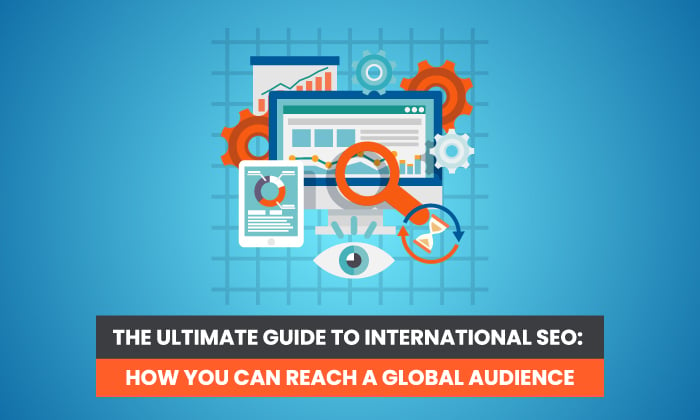
There are nearly 8 billion people in the world
—and 4.66 billion of them use the internet.Not every website can make money from international audiences, but if yours has the potential, then international SEO can significantly boost your reach.
After all, there are tens of millions of people out there looking for content just like yours, but if it’s not targeted to the right country (or in the right language), then they’re not going to find it.
International SEO helps bring your content, products, and services to global search results, and it’s the perfect way to grow your business.
What Is International SEO?
International SEO is the process of growing your website’s organic presence in international markets. It enables you to reach users in specific countries, increasing your reach and brand awareness.
Google accounts for the majority of search traffic in many countries outside the U.S. For example, 92.5 percent of search traffic in Brazil originates from Google. In India, it’s 94.19 percent.
The following graph shows the percentage of search traffic from Google in a selection of countries:
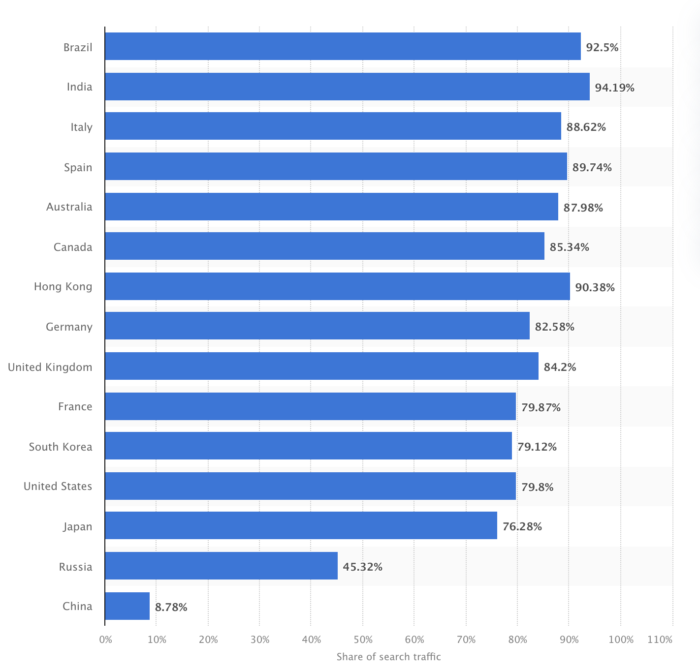
If you track your organic presence with a rankings tracker like Ubersuggest, then you might already notice that your content is ranking in different countries. This is normal; good content is good content whether it’s read in the U.S., U.K., Australia, or anywhere else in the world.

Even with close cultural and linguistic ties between certain countries, there are also a lot of differences. For example, in Australia, you can’t walk too far without seeing a Bottle-O, but many Brits and Americans might be wondering what exactly that means.
The point is that each country has a unique audience that should have its own SEO strategy—and this is before you consider throwing different languages into the mix.
International SEO is how your business navigates worldwide differences to maximize its presence in multiple countries.
Why International SEO Is Important
Google might be headquartered in the States, but it drives 92.96 percent of global traffic, and it’s used in every corner of the globe.
What’s more, millions of U.S. companies sell their products and services abroad, and some of the very biggest rely on international sales as a huge part of their business:
- Apple: 60.7 percent of sales in international markets
- Ford: 36.7 percent of sales in international markets
- Alphabet (Google): 53.8 percent of sales in international markets
- Walmart: 23.2 percent of sales in international markets
You might think, “that’s all great for those companies with massive budgets, but what about small businesses?”
Here’s the answer: SEO is a marketing channel that actually enables small businesses to compete with the big boys, and it’s no different when it comes to international SEO.
International traffic is there for the taking, and, one of the most important aspects of SEO is matching user intent. Google and the other search engines are trying to send users to the page that best answers their questions, and for many searches, locality plays into this.
With our Bottle-O example, someone in Australia might type in Bottle-O looking for their local Bottle-O’s opening times. When an American searches for Bottle-O, they’re probably to find out what on Earth one is.
The two results would be completely different, and any content that addresses the wrong user intent would have no chance of ranking.
International SEO allows you to address different user requirements in order to make the most of global interest in your products and services.
When Should You Optimize for International SEO?
Selling internationally has its challenges, but there are also big rewards.
The global e-commerce market is expected to expand by 18.7 percent a year in the next five years, and that number is even higher in less developed markets:
- Philippines: 25.9 percent
- India: 25.5 percent
- Indonesia: 23 percent
- Brazil: 22.2 percent
- Vietnam: 19 percent
This brings huge opportunities for your business—if you can implement an international SEO strategy.
One of the things you’ll hear me talk about over and over again with SEO is consistency. It’s not something you do for a month and then forget about. The same is true of international SEO: it takes time and effort.
For this time and effort to pay off, you’ve got to be confident that the benefits of going international are worth it. Before you start to invest in your international SEO, ask yourself some qualifying questions:
- Do you already have an international audience? Check the audience section of your Google Analytics to find out where your visitors are coming from. If there’s a good amount of international traffic, then it means the demand is out there.
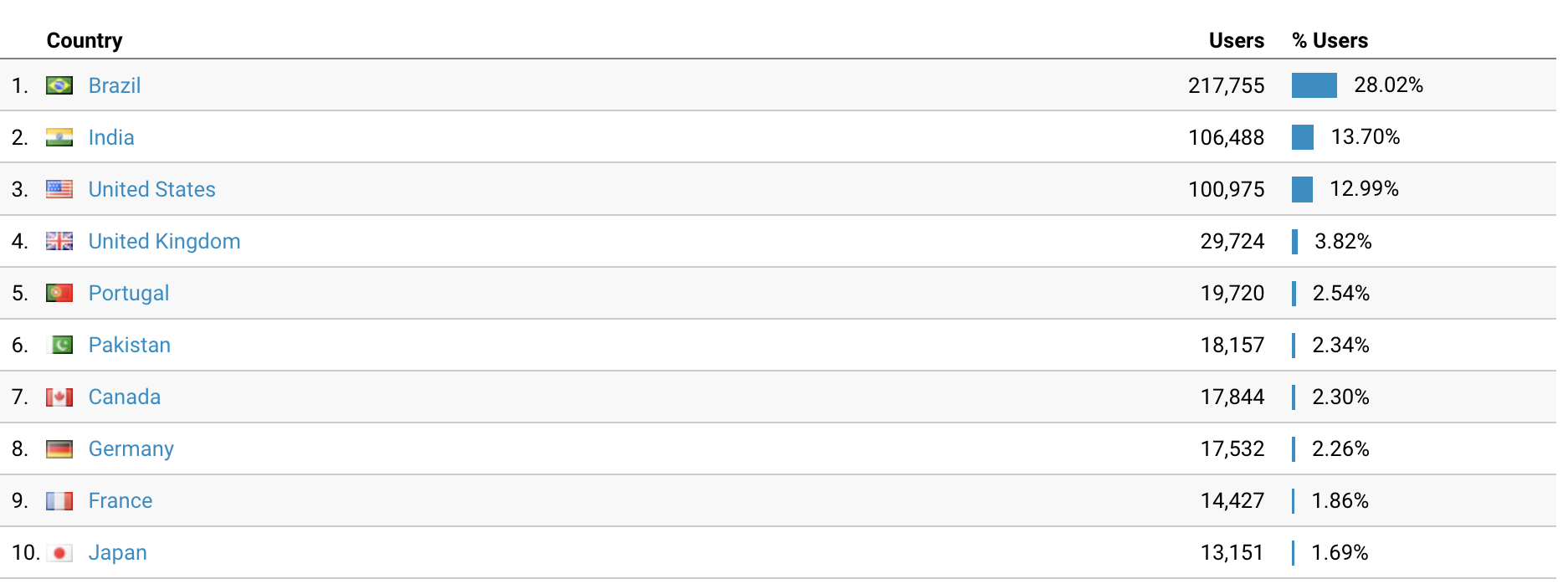
- What language are your users’ browsers set to? Again, you’ll find this information in the audience section of your analytics and it can give you a good insight into what your website visitors are looking for.
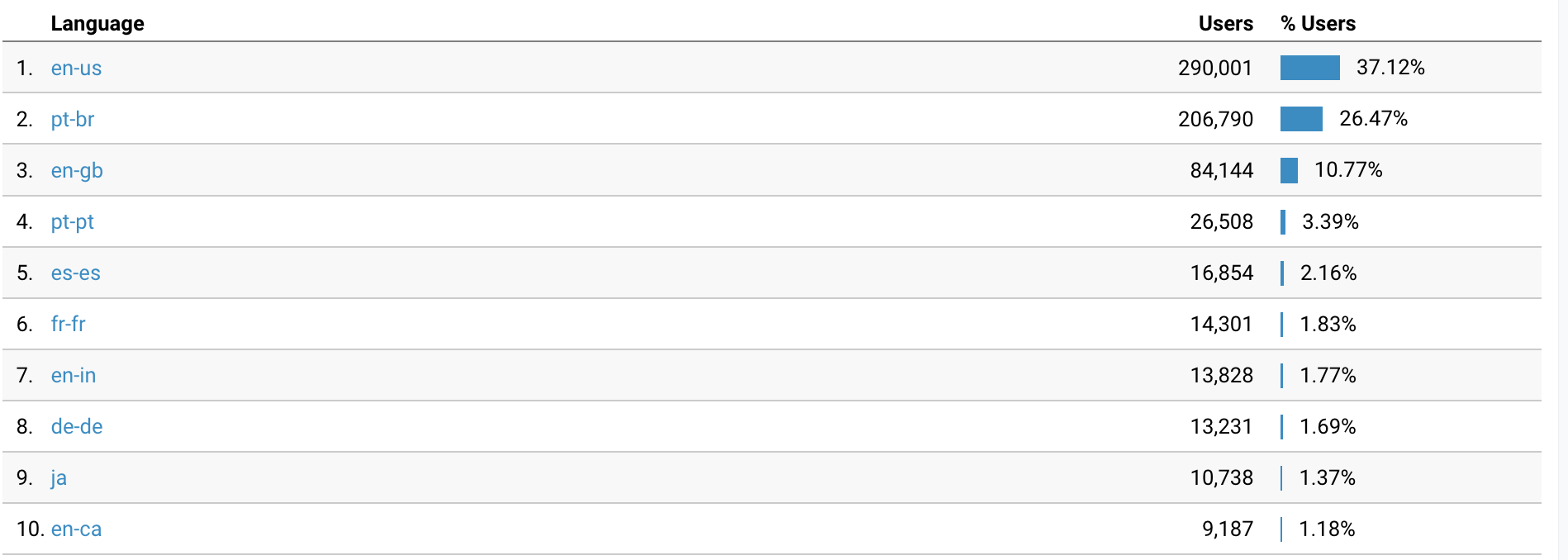
- Are your competitors doing international SEO? You can use a VPN to see what search results people are seeing in different countries. If your competitors have a strong profile in another country, then it might mean it’s a viable option for you as well.
- What are people searching for? Do keyword research in the same way you would with your regular SEO. Use Ubersuggest to see what terms people are using to search in different places.
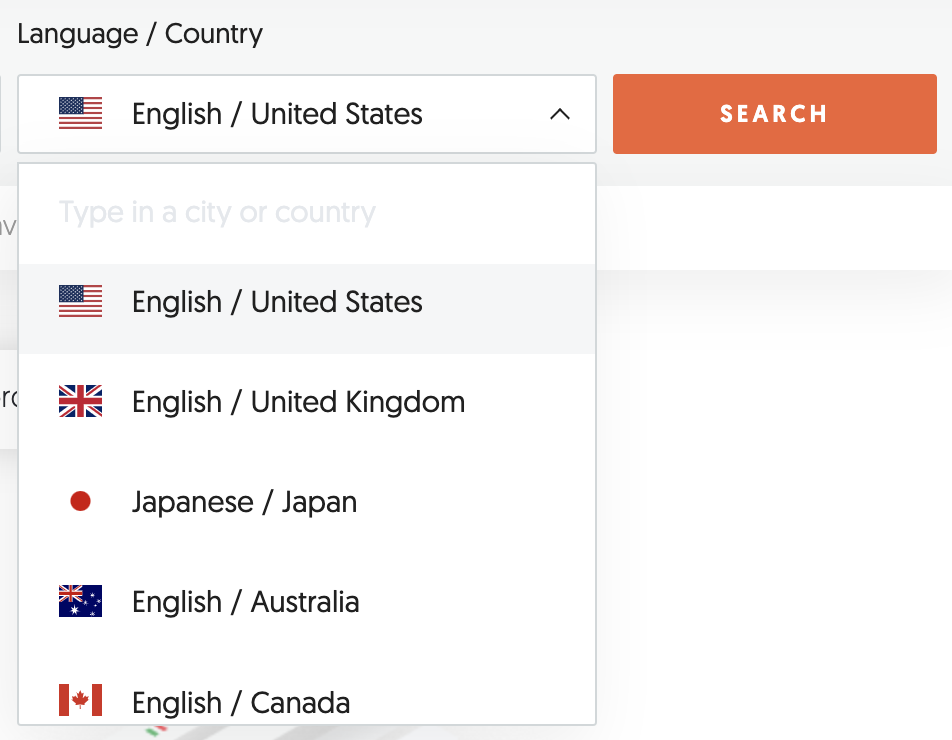
- Consider your expertise, selling capabilities, etc.: SEO isn’t just about traffic; there have to be conversions at the end of it. If you don’t have the expertise or selling capabilities to achieve this, then it’s going to limit the benefits of international SEO.
How to Implement International SEO
How should you go about implementing SEO? These five steps will help you formulate an international SEO strategy to grow your profile around the world.
1. Research Your International SEO Strategy
Nearly 70 percent of small businesses don’t have an SEO strategy
—which means they’re flying blind.Any SEO tactics you follow should be backed by thorough research.
Having a “feeling” that you’ve got potential in one country or another won’t be enough. You need to know for certain.
Ultimately, everybody has a marketing budget, and wasting it on irrelevant targeting will reduce your ROI. Ensure your resources are focused on the countries that have the most potential.
Luckily, research will set you up for each of the next steps—helping you decide on key targets, keyword choices, website structure, and more.
71 percent of marketers say using strategic keywords is their number one SEO strategy, but there are a lot more planning decisions that go into good international SEO.
- understand your capabilities
- gauge potential search volumes using tools like Google Analytics or Ubersuggest
- dig into user intent by performing manual Google searches and seeing what comes up in the SERPs for key terms you think you’ll target
- note cultural differences, such as use different words or phrasing
- highlight barriers to international sales
- calculate how you can overcome them
Additionally, give yourself credible evidence that focusing resources on international SEO will be better in the long run for your company than if you simply focused those resources on your local SEO.
To do this, project your feasible KPIs like international search traffic, revenue, customer acquisition cost, etc.
2. Choose Your URL Structure
A big decider of international SEO ranking is where the content you have created is actually coming from.
If a German wants to learn about Bratwurst, are they going to prefer to learn about it from a German website, or an American one that’s been translated into German? I think we know the answer to that question, and Google does too.
When it comes to where your website comes from, you’ve got four main options. Let’s say your website is www.bratwurst.com. Here’s what your options would look like:
- a domain with a different ccTLD (essentially like an area code): www.bratwurst.de
- a subdomain of your existing domain: www.de.bratwurst.com
- a subdirectory on your existing domain: www.bratwurst.com/de
- content on your existing domain that’s targeted at a certain language using a gTLD with language parameters: https://ift.tt/zJ6f2j9
Each option has its benefits and drawbacks.
While a separate domain is the strongest indicator that content is targeted at a specific country, it also requires you to run an entirely new website. At the other end of the scale, using a gTLD with language parameters might be the most convenient, but it gives a much weaker signal to the search engines.
40 percent of domains end with .com, but if you make a transaction search in a country like the UK, you’re going to see that many of the results are dominated by .co.uk websites (even though they might be owned by international companies).
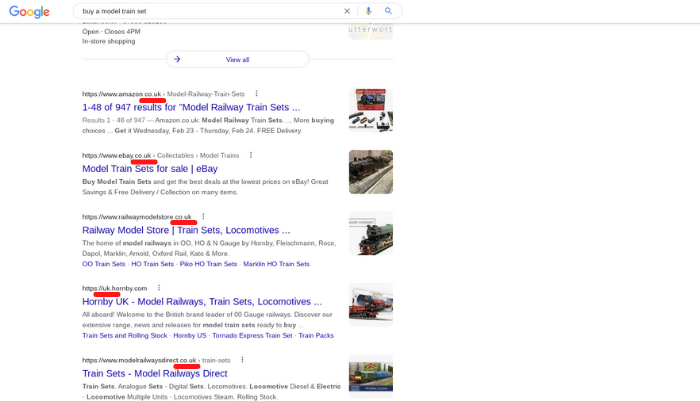
In this example of a U.K. search for model train sets, we can see a few different examples of URL structures. Not all of these companies are U.K.-based, but they all have dedicated U.K. content.
What you decide on will depend on your strategic planning and the level of focus you want to place on a given country.
3. Language Target Your Site
There are more than 7,000 languages spoken in the world. While you can’t reach them all, you do want to make sure your site shows up in your users’ primary language.
More importantly, Google wants to show results in people’s native language, so it’s going to be evaluating your website by this standard.
If you’re serious about international SEO, then don’t just rely on machine translations (they’re not up to scratch yet). Make sure every aspect of your site (however you’ve chosen to set it up) is in the correct language, from the navigation bar to the content itself.
You can also use language tags to help guide Google. For example, this “hreflang tag” tells Google there’s an alternative page available in German, allowing them to rank the correct page.
<link rel=”alternate” href=”https://ift.tt/ZouSKfx; hreflang=”de-de”/>
Another thing to keep in mind is that people don’t always want to browse in the language you expect. If you automatically redirect people to different language content based on their location tag, it can be very frustrating.
There are plenty of times when people might be in a different country and want to view your content in English, or be in America and want to view content in another language. Obvious examples include people on working visas or traveling business managers. Instead of deciding for them, give them the option by including a button they can click.
4. Tailor Your Content
Globally, users spend an average of 54 seconds on pages they visit. To get them to stay on your page, you need to create content that matches the intent behind their search queries.
We know, we know: we’re always talking about matching user intent in SEO. It’s because ultimately, if you create content that matches what users are looking for when they search your target keywords, then you’re going to have success.
In international SEO, user intent is about more than serving content in the right language. People want to see information that’s relevant to them, and they search in different ways. Just because a keyword works well for you in English doesn’t mean you can translate it directly into a foreign language and match user intent.
There are two ways to determine user intent for a country other than the U.S.
The first is to use a VPN to Google key terms from a location in the country you’re targeting. The second is to use Ubersuggest. Just enter a keyword and set the country to the one you’re targeting.

If international SEO is a priority for you, then you need to be tailoring each piece of content to fit the audience you’re targeting. This means everything from your keyword research to the topics you focus on, and the stats you use.
5. Prioritize Which Countries You Target
International SEO requires you to address countries or regions individually. They need individual strategies, content, and creatives.
This is a serious undertaking, and it means you’ve got to prioritize. There’s no point going after the world because it means you’re going to spread your resources too thin.
Find out which countries offer the most value for your business by using the strategies we previously mentioned
—using Google Analytics and Ubersuggest filters to see what countries people visiting your site are from, and what languages they speak, and researching keywords in your industry to see if there are any worth targeting in different countries.You should also understand the resources you have available to you. In SEO, it’s better to rank number one for a handful of keywords than number 50 for thousands of keywords, and it’s the same in international SEO.
Do you have the resources to create content targetting users in different countries? This could include:
- software developers or tools that can set up either separate domains, subdomains, subdirectories, or gTLD tags for your content targeting international audiences
- great translation tools and ideally a human translater to verify your translations
- writers and editors with knowledge of the culture (language, idioms, brands, popular figures, etc.) in the countries you target (if you don’t have anyone in-house, consider hiring a freelancer from the country you target to review your content, act as a translator, provide cultural knowledge, etc)
Build your authority in your key target countries, and maximize your potential.
International SEO Best Practices
International SEO best practices can be boiled down to three key points:
- Serve everything in their language: Don’t have content in one language and the rest of the website (this could be a subdomain or subfolder as well) in another. Go all in and serve the user with exactly what they need in their own language.
- Have country-specific content plans: Do country-specific keyword research and offer content that’s relevant to each group of people. Don’t simply duplicate what you’re doing in another country.
- International SEO should have an international backlinking plan: Match your backlinking strategy to the country you’re trying to rank in. Reach out to local publishers and aim to get backlinks from authoritative websites in that country.
People want content that’s optimized for them, not someone on the other side of the world. If you treat each country as unique and approach it with a unique strategy, then you’ve got a better chance of success.
Successful International SEO Case Study
A good case study to look at for international SEO is Viking, a supplier of office supplies, stationery, and furniture.
The campaign focused on seven key countries to increase online sales, drive website visibility, and increase brand awareness in the target markets. While these seven countries might be close in terms of location, they have very distinct cultures, with different languages, and unique buying habits.

Viking’s strategy recognized this and treated each country as a distinct entity. Native language marketing experts were brought on to conduct keyword research in each country and create content that addressed user intent in each nation.
This was backed up by a strong backlinking strategy that earned high authority, local backlinks that increased ranking power in each country.
The results of the international SEO efforts saw a significant increase in organic traffic across each territory, with a 140 percent increase in Austria and a 60 percent increase in France.
International SEO Frequently Asked Questions
Is it expensive to do international SEO?
International SEO can be expensive, depending on the scale of your efforts. If you’re focusing on multiple countries around the world, then costs will soon add up, but if your efforts are concentrated on a handful of targeted countries, then it’s much more manageable.
Is international SEO worth the effort?
It all depends on the size of your target audience in a given country and your ability to turn traffic into profit. If there’s potential for a large audience, and you have the ability to make sales in a given country, then international SEO can be very worthwhile.
How is international SEO different from regular SEO?
Regular SEO will normally target your home country or a chosen international country. International SEO looks to maximize your traffic outside of your primary target country.
How long does international SEO take to work?
It takes time to see the results of international SEO. Many agencies will tell you it takes four to six months to see the results, and this is a good guide. The thing to remember is that the more you do, the more it continues to grow, so it’s a very cumulative thing.
Conclusion: International SEO
It’s a big world out there, and wherever you live, there’s a massive audience abroad who could benefit from your content.
Rather than trying to reach all of them at once, international SEO encourages you to focus on specific target demographics with country-specific strategies.
Before you embark on international SEO though, you must do your market research with tools like Google Analytics and Ubersuggest. You need to be confident that there is an audience for your content in the country you choose, and that your business is capable of turning website traffic into profit.
If you find your products and content would do well with an international audience, then it’s time to start optimizing for international SEO.
What countries are you targeting?
from Neil Patel's Digital Marketing Blog https://ift.tt/sWm8TbI

No comments:
Post a Comment